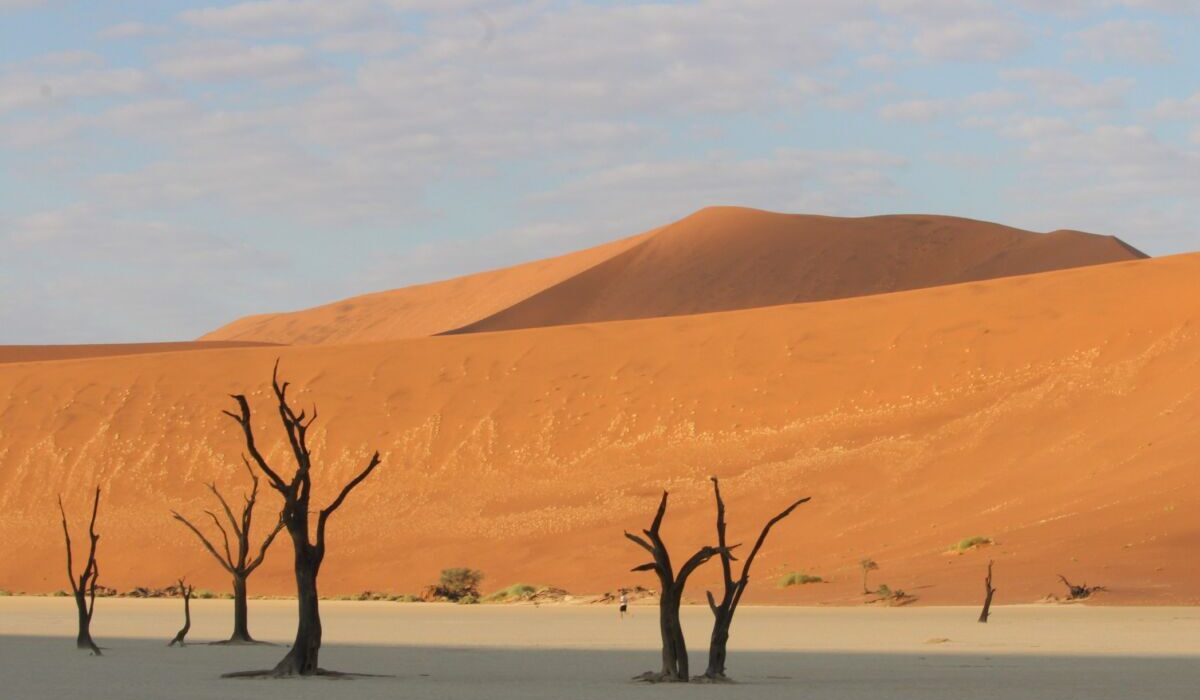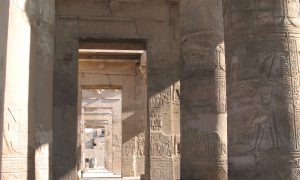by Kate Dernocoeur, guest blogger
At the end of the road westward out of Sesreim is a stunning and magnificent experience in the area called Sossusvlei. Every journey to Namibia rightfully should include time in this place, which is within the protected borders of the Namib-Naukluft National Park. It’s a chance to witness the grandeur of the world’s oldest desert, the Namib, and its dunes, which are among the largest in the world. The sand is red due to abundant levels of iron oxide, and is reportedly five million years old. Fun fact: “The wind in the Sossusvlei area blows from all directions, which means that the type of the dunes here are known as ‘star dunes.’ This is because the winds cause the sand to form star shaped dunes with multiple arms.” [Source: https://www.sossusvlei.org/attractions/dune-45/ accessed January 25, 2023]
We headed out from our Sesreim campground before daylight. The goal was to be on the dunes by sunrise. My friend and guide, Ian Brown, and I headed up “Big Daddy” while Steeve stayed below. Among the most famous of dunes, Big Daddy averages an elevation of 1,150 feet. From its flanks, we earned amazing vistas. To the east, the sunrise offered steady illumination of the quiet world around us. To the west below us was a bird’s eye view of the huge white-clay salt pan known as “Deadvlei” (the word “vlei” means “a lake or marsh between dunes” in Afrikaans). As the sun rose, the dark shadows lingering behind the graceful curves of the dunes made for an entrancing scene.
Deadvlei is special because of the dessicated trees dotting the valley floor, the result of flooding by the Tsauchab River about 600-700 years ago. The tree skeletons are black from being scorched by the sun. They endure because dryness prevents them from decomposing. White valley, black trees, red dunes, and blue sky. Ah, the magic of the natural world! Our descent? It was a little wild (and a lot of fun–see the video)!
We headed across the valley to the large salt and white clay pan also named Sossusvlei. Thanks to two years of unusually ample rain, there was water in the pan, reflecting the beauty of the hillsides. There was some welcome greenery, and the excitement of spotting oryx on the hillside, and a jackal who trotted past us close by.
Soon, we headed back toward Sesreim, to Dune 45—so named because it is 45 km from the gate into the park. At Dune 45, I had a special mission. A good friend at home sustained a paralyzing injury while sandboarding (now outlawed) down the dune in 1997. Ian and Steeve stayed behind while I walked up the 500+-foot dune. From my journal: “It wasn’t hard, but it wasn’t easy.” It was a welcome bonus, once one descending couple went past, that not another soul was on the dune that morning. I had only the breeze for company, plus some interesting beetles and skittering dune lizards.
I reached the top and sat a while reflecting on my good health and fortune. I channeled Jocelyn, who is an athlete to this day. Mindfully, I reveled in the breeze and warm sun on my face, then gathered a couple of handfuls of red sand to take to her.
Later in the day, Ian and I visited nearby Sesreim Canyon, a small but interesting 100-foot deep by half mile long geological feature. The Tsauchab River carved it through layers of conglomerate and limestone a couple of million years ago. Early travelers in the region used to drop their buckets to get water, using six lengths of tied-together ox-cart reins (“sesreim” means “six reins”).
Dinner by the fire that evening was welcome. Then our sojourn was punctuated by a hearty wind storm that blew in around 3:00am and refused to let up. After daybreak, while we scurried around securing our equipment and collapsing the car tents and Ian’s “sand-sieve” of a ground tent, a bemused oryx stood just outside the wall of our campsite. I was compelled to interrupt our frantic efforts to take some photos. Then we bolted out of there, and headed back to the capital city of Windhoek to regroup.
[Recommended reading: It Rained in the Desert, by Jocelyn Dettloff, at Amazon.com, with an audio version soon to be available.]
Kate Dernocoeur unleashed her pent-up Wanderlust in 2022 and her recent blogs at “Generally Write” (www.katedernocoeur.com) reflect those weeks of traveling! When she lands at home, it is in Lowell, Michigan, where she lives on a quiet, rural property that lends itself well to her craft of writing.




















